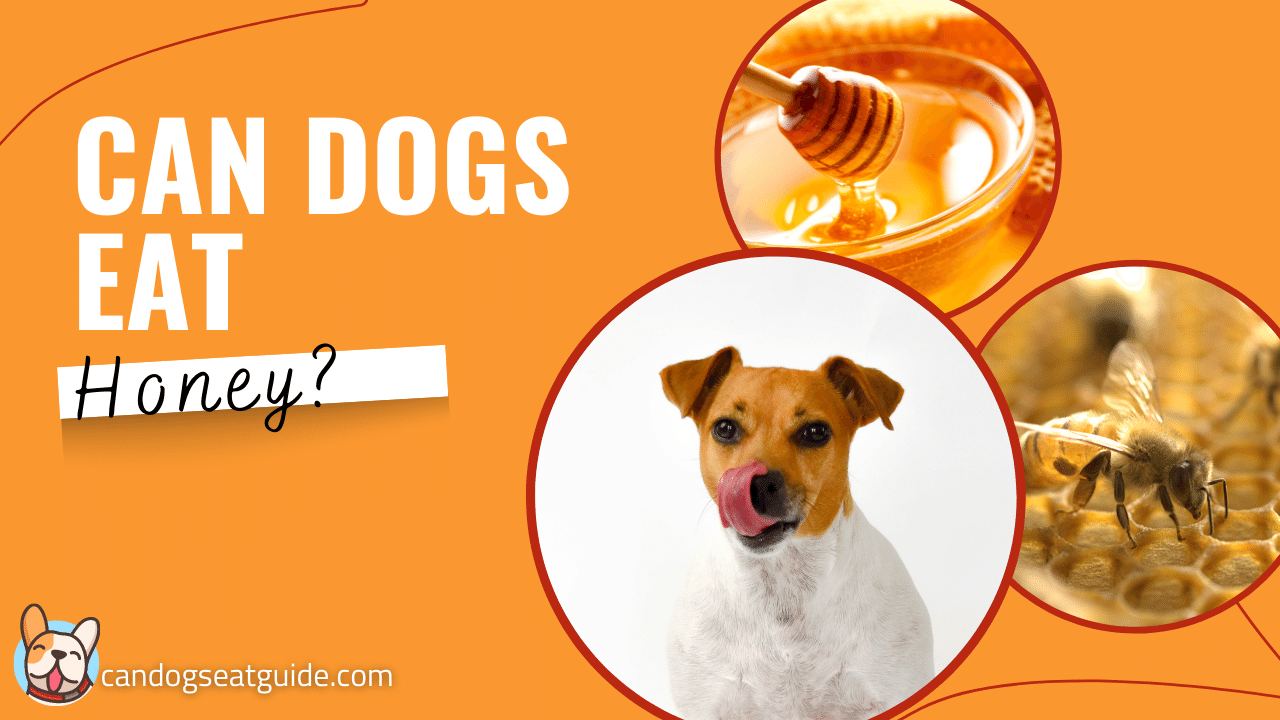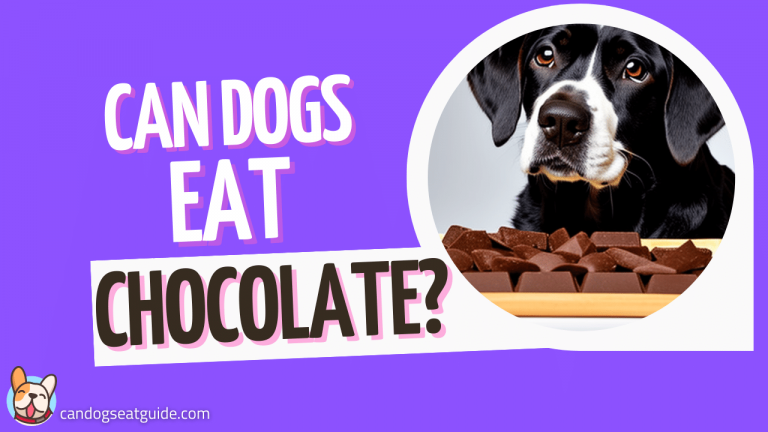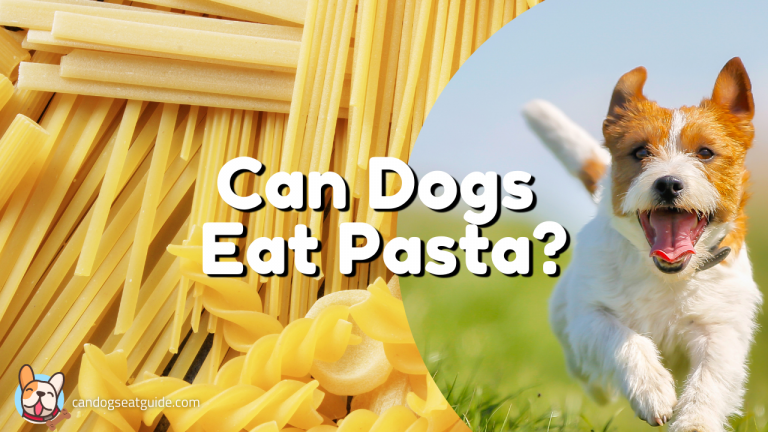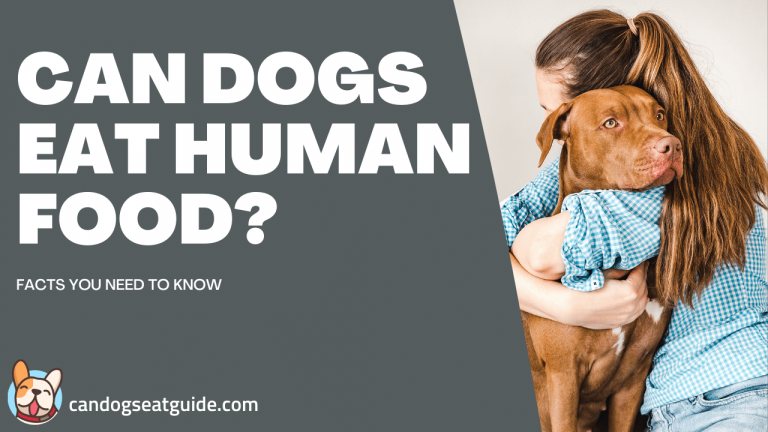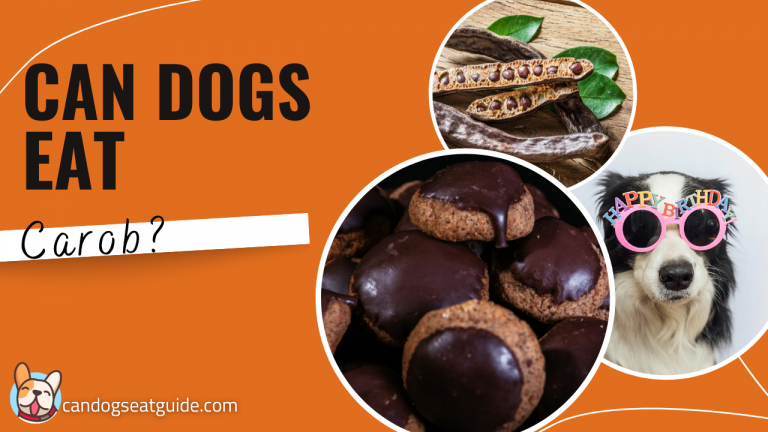Yayy! It’s so exciting to see if the so loved by us, humans, honey is safe for our dogs.
“Can dogs eat honey?” was a question that was for long in my head because I love to add honey to almost all the sweet treats I make for my family.
Honey is a better sweetener than sugar or any other kind of sweetener that contains xylitol. That’s why it is used so much by me but it also has so many benefits for our immune system and body.
Now it’s time to check if honey is that good for dogs too and can dogs eat honey daily or only as a treat rarely?
Keep reading as at the end of the article you will find very tasty treats that can be consumed by both of you – you and your dog.
What is honey?

You may be like I know what is honey why I should read this but it’s surprising how little people actually know about it. And my task here is to give you more knowledge, so here we go.
Bees collect nectar and honeydew from the flowers and store it in their hives and from there we get the well-known honey.
But what is the purpose of bees making honey?
It’s actually their survival food in winter when there are no flowers and plants to collect nectar from.
The nectar they collect contains around 70-80% water, while the honey they make contains roughly 18% water.
How do they decrease the water amount?
This is the job of worker bees that fan the nectar to vanish the water and moisture and make the thick honey we love.
10 Types of Honey
How many types of honey do you think there are? 3-5?
Well, they are much more.
1. Crystallized honey
Honey that is crystallized is a result of the crystallization of some amount of glucose. It can be returned easily to its liquid form by warming.
2. Pasteurized honey
This type of honey is created by pasteurization. A process that is made to destroy the yeast found in honey by heating it to a temperature that is over 100°C. It makes the honey smoother and some people and companies tell that it makes the shelf-life of honey longer.
3. Raw honey
“As it exists in the beehive” is the phrase that describes this type of honey the best. Raw honey isn’t pasteurized. It contains some pollen and very tiny particles of wax that couldn’t be filtered out.
4. Strained honey
Strained honey is honey that was filtered out for wax, propolis, or other defects but without removing pollen, enzymes, or minerals.
5. Filtered honey
This type of honey is filtered to the level to extend all fine particles, pollen grains, air bubbles, etc. In this process, the honey is heated to 66-77°C and then filtered. When honey is filtered it’s more difficult to get crystallized that’s why it’s preferred in the markets.
6. Creamed honey
You can find it also as whipped honey, spun honey, set honey, etc. The raw honey has been processed to control the crystallization and the result is the creamed honey.
7. Dried honey
It’s done by extracting all the moisture from the liquid form of honey and it turns to nonstick granules.
8. Comb honey
The rawest form of honey. It takes more patience to be produced than liquid honey. The comb honey is the hexagons filled with honey made by the worker bees. These hexagons get cut into squares and put in boxes. They were much more common in the past than now.
9. Chunk honey
Combination of liquid and comb honey.
10. Baker’s honey
It has a different color, odor, and taste due to the fermentation process that has begun or because the honey was overheated.
Can Dogs Eat Honey Safely?
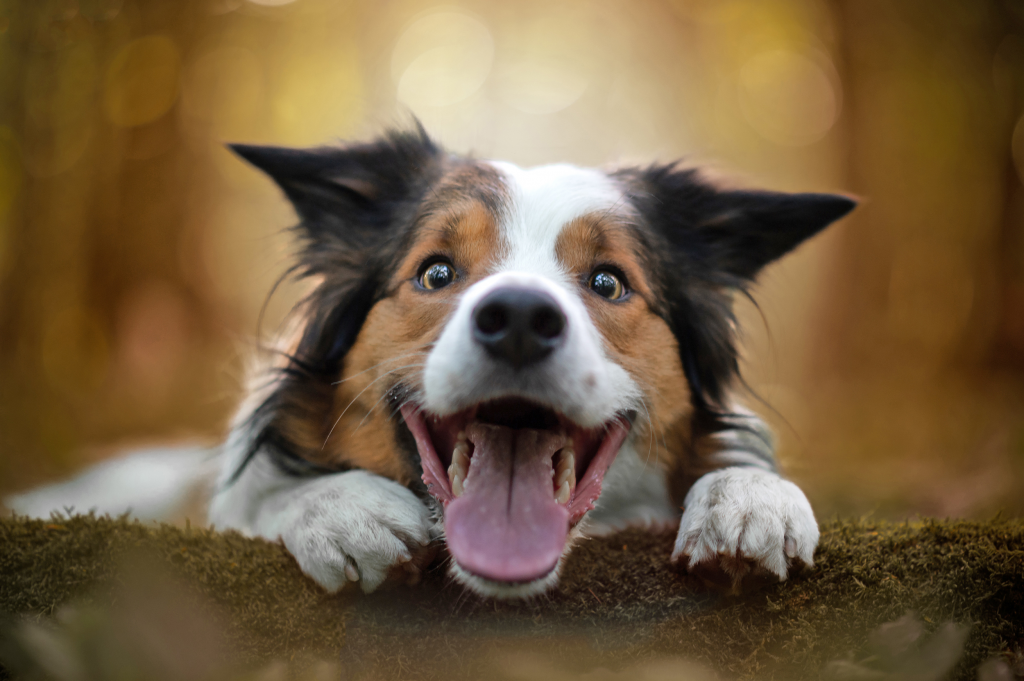
Yes, dogs can eat honey safely but please don’t miss the next paragraphs as they are very important.
Dogs can have raw honey rarely in small amounts. But you should know that even as it may be used to replace sugar in some recipes that doesn’t make it less sweet. Honey is high in sugar. Yes, it contains vitamins too but they can’t beat up the levels of sugar.
We all know that high amounts of sugar lead to obesity but not only in humans. It’s the same for dogs too.
Dogs mustn’t eat more than a tablespoon of honey a day.
Down you can find all the benefits your dog can get from eating honey.
Which Type of Honey Is Safe For Dogs?
The best and safest type of honey is raw honey.
Why?
Because that’s the only form of honey except for dry honey that hasn’t gone through many processes and hasn’t been heated to 118°C. It isn’t pasteurized. It contains pollens – it’s good they to be eaten as this way the body of the dog can have enough amount of antibodies to fight the pollens next spring.
When Honey Can Be Dangerous to My Dog?
Honey can be dangerous to dogs that have problems like:
- obesity;
- diabetes – honey can increase blood sugar levels too much;
- compromised immune system – dogs with autoimmune diseases, lupus, or cancer;
- tooth decay;
You shouldn’t give honey to your puppy as their immune system is still in the developing stage. Eating raw honey isn’t good for them as it may carry botulism spores, which can lead to gastrointestinal issues. It’s the same situation with human babies, they aren’t allowed to have honey in the first 12 months of their lives.
It’s not safe for dogs that react to bee stings as they may react to the honey too.
It’s very recommended in these cases to consult with your vet as adding honey to their diets can be extremely dangerous and life-threatening.
What is Botulism?
Botulism is a rare condition that is often caused by eating raw meat, but it can happen to puppies by eating honey too.
Botulism caused by honey in adult and senior dogs is very very rare.
What are the signs of botulism?
Usually, it starts with weakness in the rare legs, and in the next 24 hours, it spreads to the front legs, head, and face. If it is left untreated it can lead to the paralyzation of dogs.
Honey Benefits
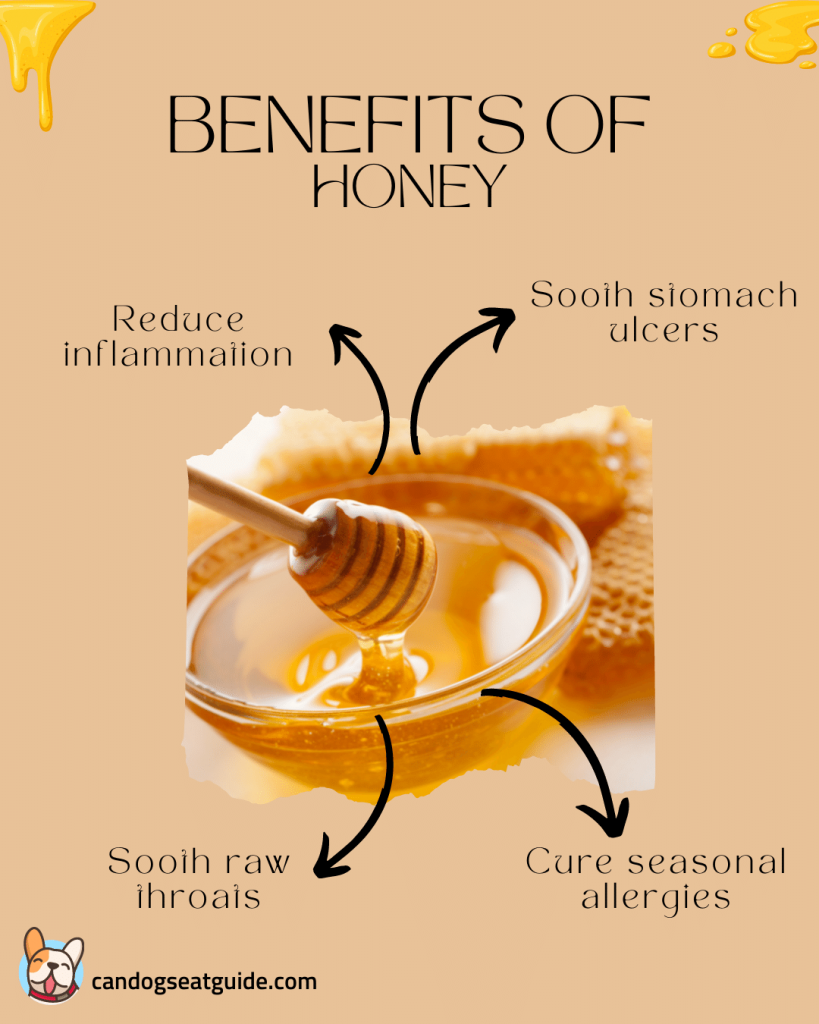
Although there is not any scientific evidence we can believe that honey can cure seasonal allergies. Why? Dogs that have a pollen allergy can eat raw honey to reduce this allergy – by consuming these pollens the immune system creates antibodies.
It’s well known for its antioxidant properties. Honey contains vitamins A, C, and E, phenolic acid, and flavonoids. They help in reducing inflammation and may boost the immune system of your dog.
For the energy level, proper function of metabolism, and brain of your dog raw honey provides B-complex vitamins.
Honey contains minerals like magnesium, copper, and manganese. These minerals help with bone development and management. They help in the production of collagen.
Honey can be used also as a home remedy. It’s great for wounds with its antibacterial and anti-inflammatory properties. A thin layer is enough to fight wounds, eczema, hot spots, etc. It’s also great for joint problems in senior dogs.
Signs of Toxicity in Dogs
If your dog had too much honey, you may notice some of these signs:
- lethargy
- vomiting
- diarrhea
You should take your dog to the vet immediately.
Can Honey Help With Kennel Cough?
Let’s start first with:
What is kennel cough?
Kennel cough is a mild disease and the main sign of it is a cough that can be chronic and last for a few weeks. Other signs are runny eyes and nose, lack of appetite, wheezing, and in some cases, it can get into depressive behavior.
Kennel cough can be referred to as infectious tracheobronchitis.
Is honey a good home remedy for kennel cough?
Honey is known that it can relieve sore throat. And sore throat is one of the signs of kennel cough. Depending on the size of your dog you can give them a little amount and see if it will work for them.
As you already know raw honey has antibacterial and antimicrobial properties. They can fight the cause of sore throat and cough. But mainly honey can’t help much with kennel cough, the most it can do is relieve sore throat.
If you notice some signs of kennel cough in your dog, let your vet know immediately as it can turn into a chronic cough very fast.
How Much Honey I Can Give to My Dog and How?
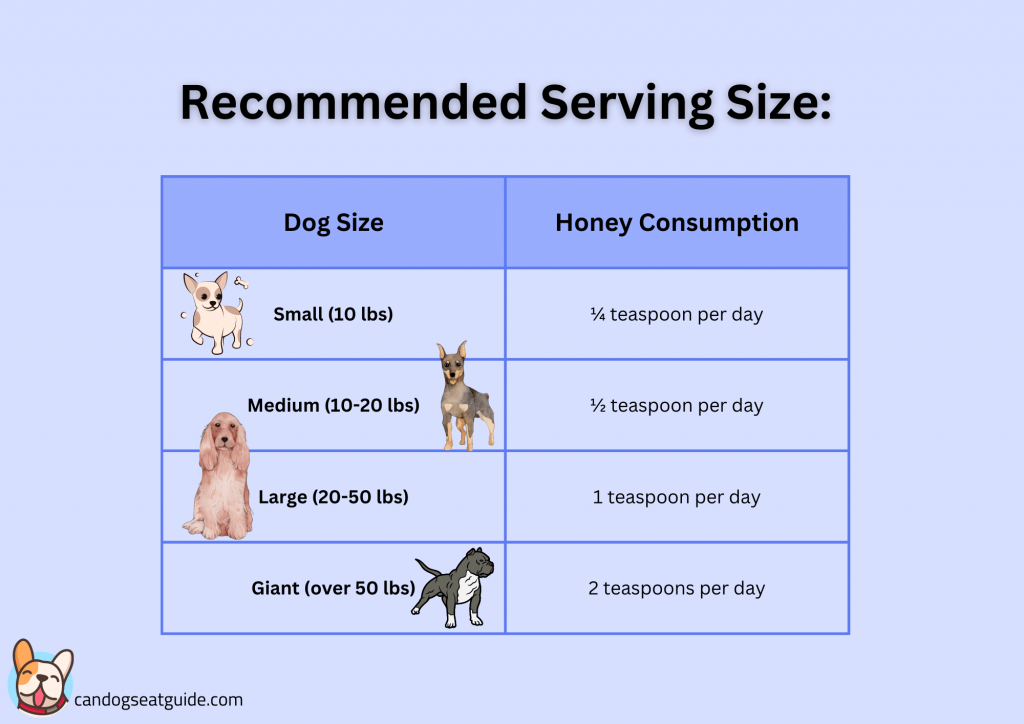
One tablespoon of honey contains 17g of sugar and 70 kcals. So one teaspoon is around 6 grams of sugar 21-23 calories.
Honey can be given directly from the teaspoon as dogs will spend some time licking it or it can be included in some treats – like the ones I have included in the Recipe section. Some dog owners shared that their dogs most enjoy it when honey is added to the top of their food.
Can Dogs Eat Honey: Dog-Friendly Recipes
1. Homemade Honey Dog Treat Recipe
Recipe by K9.ROCKS.
Note: Don’t do this dog treat if your dog has lactose intolerance or opt-out of plant-based milk and butter.
Ingredients:
- 5 oz brown rice flour;
- 5 oz oats;
- 1.5 oz honey;
- 2 whole eggs;
- 1 oz melted butter;
- 0.25 oz baking powder;
- 3.5 oz milk.
Steps:
- Preheat the oven to 200°C and put parchment paper on a baking tray.
- Into a mixing bowl add the eggs and lightly beat.
- Add the honey, baking powder, milk, and butter.
- Stir all the ingredients.
- Pour the mix in the brown rice flour and oats, mixing to bring together a smooth dough.
- Turn the dough out onto a surface and knead until a ball is formed.
- Roll the dough out flat to 1 cm thick then cut with a cookie cutter.
- Place the cut treats onto the baking tray and continue with the remaining dough. Re-roll any excess dough and continue to cut until finished.
- Bake the tray of homemade honey dog treats in the oven for 25 minutes.
- Remove the treats from the oven and allow them to cool, store in an airtight container and use within 1 month.
2. Brie’s Banana and Honey
Recipe by TheBritishBaker.
Ingredients:
- 2 cups of water;
- 2 mashed bananas;
- 2 tablespoons of honey;
- 1 teaspoon vanilla extract;
- 1 egg;
- 4 ½ cups of whole wheat flour;
- 1 teaspoon of baking powder.
Instructions:
- Preheat oven to 350°F (175°C).
- Combine water, mashed bananas, honey, vanilla, and egg in a large bowl.
- Stir in whole-wheat flour and baking powder.
- Beat dough with an electric mixer on medium speed until ingredients are thoroughly combined.
- Turn dough onto a floured surface and knead until no longer sticky.
- Roll out dough to 1/4-inch thickness and cut into mini shapes with your favorite cookie cutter.
- Place dough shapes on a baking sheet.
- Bake in preheated oven until cookies are lightly browned, about 20 minutes.
- Turn off the oven and leave cookies until thoroughly dry and crisp.
3. Peanut And Honey Dog Treats
Needed ingredients:
- 1/3 cup of raw honey;
- 1 cup of crunchy peanut butter;
- 1 cup of low-sodium chicken broth;
- 1 cup of water;
- 1 cup of steel-cut oats;
- 1 cup of oat bran;
- 3 cups of whole wheat flour.
Instructions are in the video:
Can Dogs Eat Honey: Fun Facts About Honey
- To make one pound of honey, the bees in the colony must visit 2 million flowers, fly over 55,000 miles, and will be the lifetime work of approximately 768 bees.
- A single honey bee will visit 50-100 flowers on a single trip out of the hive.
- A single honeybee will only produce approximately 1/12 teaspoon of honey in her lifetime.
- Honey never spoils. When sealed in an airtight container, honey is one of the few foods known to have an eternal shelf life.
- There are 20,000 species of bees on earth and only a small fraction of them make honey.
- Honey comes in different colors, from transparent to almost black, and darker honey has higher antioxidant levels.
Wrapping Up!
If you are careful with the amount you give to your dog and your doggo is completely healthy, then it’s okay to give them a bit of honey from time to time. As we love to say almost everything in moderation is healthy and safe for humans and dogs.
Guys, if you have any unanswered question, feel free to ask me. Let me know what else you wonder if dogs can eat and we will answer by a post quickly.

